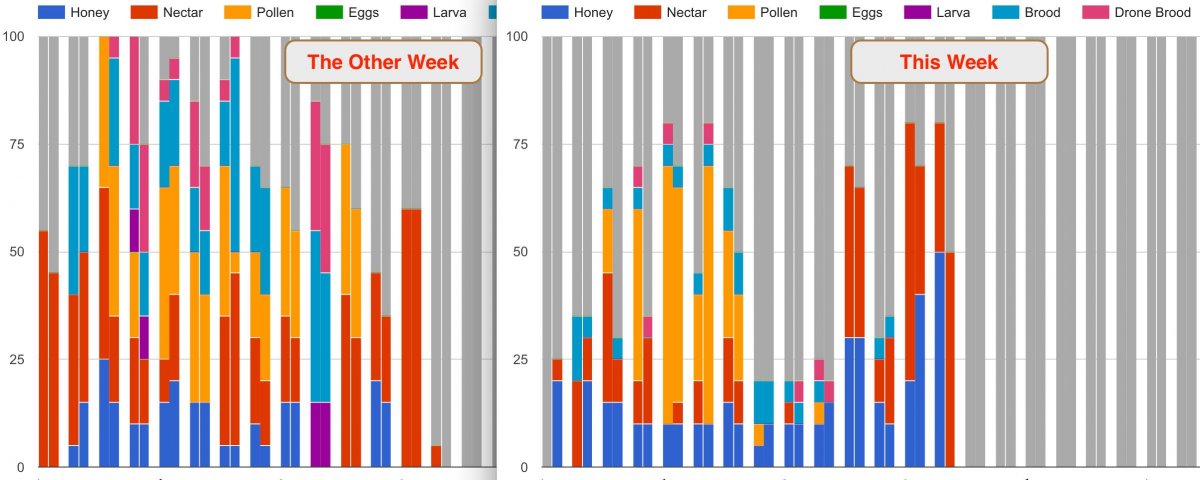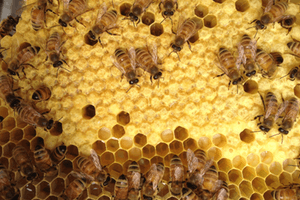- All-In-One Beekeeping for the Bees
- +1-608-728-8233
- info@beepods.com
Why we keep Hive Inspection Notes and Data (AND WHY YOU SHOULD, TOO!)

 One of the most important tasks any beekeeper can do as part of their inspection is record tracking. Every time a hive inspection takes place, someone should be taking notes. Not only does this practice help you to reinforce what you are seeing, but it will help you address issues that arise in the hive at a later date. Read on to find out what you should keep track of in your hives, plus some tips for how to make the process easy and accurate.
One of the most important tasks any beekeeper can do as part of their inspection is record tracking. Every time a hive inspection takes place, someone should be taking notes. Not only does this practice help you to reinforce what you are seeing, but it will help you address issues that arise in the hive at a later date. Read on to find out what you should keep track of in your hives, plus some tips for how to make the process easy and accurate.
History repeats itself
“Who tracks what they see or do when they run their inspections?” I asked when I spoke to one of the many bee clubs this last year. Only a few hands went up. As my thoughts began to fly, it finally hit me how many beekeepers both old and new do not keep hive inspection notes and data. It is one of the most important things all beekeepers can do to help keep healthy colonies of honey bees. The underwhelming numbers of beekeepers who raised their hands at other beekeeping clubs was the same – except for one group. We were able to identify how data had played a role in saving their colonies. They were able to understand a complete timeline backwards from when they first noticed the issue of smaller population, which, as it turns out, was that the requeening did not go as planned. They were able to diagnose the cause instead of just trying to treat the symptom.
There are a lot of other examples we could talk about, too. New or old beekeeper, tracking notes will help you teach or learn what is really going on in a hive. Keeping good colony records is like tracking your own health or taking notes in class, as Hillary Kearney says.

It is hard to understand how they will help in that instant, but over time, things begin to make sense and patterns arise. The only way you can see these patterns is if you create the habit of writing down what you see. Who knows – maybe if you write down what you see you may find something that can help your fellow beekeepers like we do with the Beepods Beekeeping Philosophy.
Organization is everything
If you are a NewBee, inspections can be overwhelming. It’s fun to just take a look inside and be fascinated by the bees, but at the end of the day, what are you looking at and how can you tell? Maybe you do know what you are looking at, but sometimes we forget to look for other things. That’s why it’s a good idea to keep a journal next to you and a templated form if you are able as a checklist for your inspections.
There are a variety of templates available to beekeepers. It is best to find one that suits your needs or create your own. Our Hive Inspection Forms were designed for the Beepods System, but other Top-Bar Beekeepers have followed it because it provides a solution for what they need. Others have used Hillary Kearney’s notebook for traditional systems and even our own Scott Offord has played around with other tracking methods for top bars so we can help to improve our own. Not everyone starts out like Les Crowder and is able to write books and share stories about what they’ve learned. It takes careful tracking, reflection and journaling to be able to know that what you are sharing with others actually works.
What to track
What you track depends on your goals of beekeeping. For a commercial beekeeper, they will have to move quickly through thousands of hives, making their inspections very high level. For citizen scientists, educators and many of our customers, they are focused on building a contextual data pool that will help us identify why Colony Collapse Disorder (CCD) is happening and potentially how we can prevent it.
There are a variety of items to look for during an inspection and each one could be important in that moment or down the road. Here are a list of generalized items that we collect during every inspection:
- Environmental/contextual information like weather, signs of animals, etc.

The Hive Inspection Forms are an easy way for Beepods and top bar beekeepers to collect data out of their hive. Data from their inspections can be input into the Healthy Hive Management Software to better analyze the health and growth of your colony. To purchase an inspection kit or access to these forms, Click Here.
- Where bees are located and their temperament
- Presence of the queen, eggs, larva, nutrition
- Presence of disease
- Noticeable differences in hive activity or shape from the last inspection
- A bar-by-bar inspection looking for brood and monitoring hive growth
- Actions taken during the inspection
- Questions about what we are seeing/general qualitative notes
We take very granular notes because our ultimate goal is to identify how to help our colonies be successful. Sometimes in the diagnosis of a disease or understanding symptoms, it is the tiniest detail that could determine the initial cause of symptoms. Our Hive Inspection Forms have allowed us to systematize our data collection and review for each hive and every yard for our personal hives and our customers.
This is why we have set up our HONEY DO LIST and email we send out to all Beepods Beekeepers and others who sign up, to share with them specific things to note or look for during their inspections. Beekeeping inspections should remain consistent and regular, but what is going on in the hive will change and should be noted.
To Read more about the Beepods HONEY DO LIST or to sign up click here!
The Best Way To Track Your Information
So how do you track what you see while you’re running an inspection? Well, you grow an extra set of hands, of course! Just kidding. Actually, we always suggest taking a secondary out with you to your hive if you are able. This extra set of hands makes things a breeze if you are working the hive and telling your secondary what to write down.
For Beepods Beekeepers, you should have your Bar Stand that allows you to set the bar safely down and observe the details. Or, if you have a good memory, observe each bar and then write down your notes or use the Healthy Hive Management Software through the lab right by your hive.

Hive tracks offers a tool to track traditional style equipment data tracking. There are many ways to track data. Choose the solution that best fits your style of equipment and beekeeping philosophy.
If you are working a traditional style setup (langstroth), HiveTracks has made some significant improvements on their app, but it still may not be as detailed as you’d like. There are others out there as well – we may do a post on those in the future.
Other beekeepers have shared that they record a memo on their phone or just take a notebook and each page is a different hive inspection. Whatever you do, just be consistent and build the habit of taking notes.
Conclusion
It boggles my mind that there are so few beekeepers who track the history of their hives – even with a simple notebook, noting what they have seen or observed. Each year, these are the same beekeepers saying they don’t know what they are doing wrong when their hives die at some point during the year. DON’T BE ONE OF THOSE BEEKEEPERS. Regardless of what notes or data you are tracking, build the habit. You never know when it may come in handy. If you’d like to see how our Healthy Hive Management Software and Hive Inspection Forms work together, click here to see more and get in touch with us, and we can get you set up!
Related Posts
Democratizing Beekeeping Data: Building a Research Community of Citizen Scientists
What is happening with Beepod’s Technology in 2017
Healthy Hive Management Software Frequently Asked Questions
Purchase Your Beepods Inspection Kit Here!
- 30 day Beepods Membership Trial Included

- 10 Inspection Sheets
- 1 Demo Sheet
- Hard Case Clip Board for Safe Storage
- Instructive Videos included with purchase
- Easy to add to your Beekeeping Kit and even easier to follow the checklist to make sure you do not miss anything.
Brad James
Latest posts by Brad James (see all)
- Where does pollinator week come from? A brief History of Pollinator Week and its impact on supporting pollinators - June 17, 2019
- Honey Bee Breeds and Their Attributes - March 2, 2018
- My 3-Year-Old Daughter Loves Bees - December 5, 2017



